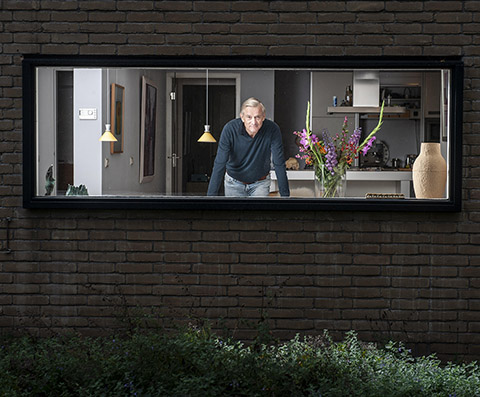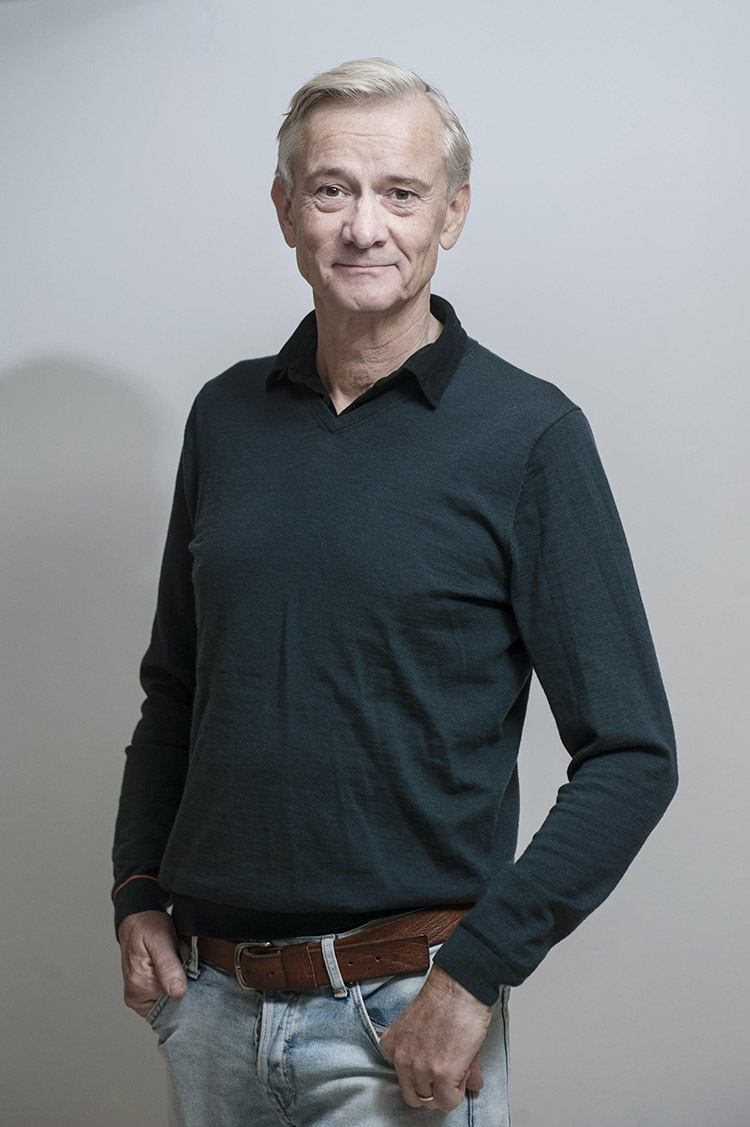
Marcel Jonkman doesn't have long
A good death
Death can be beautiful, says Marcel Jonkman (60). Many people don’t realize, but he has seen it when he helped one of his patients die. She was a suffering 83-year-old woman and her general practitioner refused euthanazia.
He saw it again in 2008, when he helped end the suffering of six-week-old Max. Baby Max suffered from a severe form of Epidermolysis Bullosa (EB), also known as the butterfly disease – Jonkman’s speciality.
EB is an incurable disease that prevents the layers of the skin from adhering to each other properly. The merest touch raises painful blisters on the skin – making it delicate as the wings of a butterfly. Blistering can also occur in the mucous membranes, the mouth, the oesophagus, and the nose. Baby Max was in such terrible pain that his parents asked Jonkman to euthanize him.
Love
‘I said: “I want to make sure you love him before I do this”’, Jonkman recalls. ‘“Take him home for six weeks before you come back.”’ He ponders in silence for a while. ‘How can you test love? Bonding with your child and then having to let go again because he’s suffering? That’s difficult, but otherwise I might only euthanize the boy in order to alleviate the parents’ suffering. And that’s just not a criterion.’
The boy ended up dying peacefully on his mother’s stomach. ‘It was a very intimate, beautiful moment’, he recalls. ‘Just like the birth. Not every death is a good one, but some can be.’
And now, ten years after Max’ death, death is coming for Jonkman too. When he received the diagnosis on 21 August – metastasised pancreatic cancer – he knew exactly what it meant. ‘The survivability of pancreatic cancer hasn’t improved over the past thirty years’, he says. ‘As a doctor, I knew it was a lost case.’
He had been feeling under the weather for a while. He was tired all the time and even began to look forward to retirement, something rather uncharacteristic for the hard-working dermatologist.
Fever
He had fought for thirty years to relieve the suffering of his patients, many of them children. He had looked for – and found – one of the causes of EB, had founded a world-renowned diagnostic centre at the UMCG, and had made leaps towards the development of a drug to treat the disease. But the demands of his work started to drag on him physically. When he finally landed in the hospital with a high fever, it turned out there was a secret killer hiding in his body.
I don’t want to be a patient. Not yet.
He doesn’t want to hide from reality. ‘You have to ask yourself: am I content to die? I’ve accomplished everything I wanted in my career. There are others who can take over the work.’
When he was diagnosed, he knew he didn’t want to undergo chemo. The therapy may or may not add two more months to his life, but it would certainly make him very ill. ‘I don’t want to be a patient’, he says. ‘Not yet.’
So he made a conscious choice to receive only palliative care, only treating his symptoms to alleviate the fatigue and pain caused by the cancer. Hopefully, he will have another six months. Of those, five weeks have already passed. ‘I try to seize the day’, he says. ‘Nietzsche wrote: “Liebe das, was nothwendig ist.” – amor fati.’
Prop
He sits in the study in his large, well-designed home at the Goeman Borgesiuslaan in Helpman. There’s an immaculate white couch, a large Apple computer, and a view of his wet green garden out the window. The noise of the city disappears here. A small, ornately framed painting of a shepherd and his sheep stands out in the otherwise modern space; it once belonged to his parents.
One other thing stands out, peering with unseeing eyes from his bookshelf: a skull Jonkman secreted away from the ruins of the Broerkerk as a student in 1977, just before the UB replaced the old church. ‘I wasn’t supposed to, but I was a medical student and looking for a prop.’ He smiles. ‘It’s not like they’re gonna punish me now.’
Near the skull are stacked the 25 doctoral theses for which he served as an advisor during his dermatological professorship. It may not seem like many, but Jonkman says he prefers quality over quantity – and four of his PhD students graduated with honours.
Jonkman’s speciality is a very small field, and there wasn’t a lot of money for research. ‘I had to spend my money wisely’, he says. ‘So I only funded the very best ideas.’
Best publication
His strategy of backing only the best ideas was a good one, as shown by both his personal success as well as that of his research group. In 1995, Jonkman discovered that a shortage of the BP180 protein caused a type of blister disease, and that this must be due to a gene mutation.
Shortly after, he met a patient who had one healthy patch of skin among all the blisters. ‘During a study in Philadelphia, we found out that this gene sometimes mutates back, like a natural form of gene therapy.’
The discovery led to what he feels was his best publication ever, in the journal Cell. Unfortunately, the patient’s healthy patch of skin never grew larger than six centimetres. Nevertheless, ‘it was bizarre and so amazing’, says Jonkman. ‘It was a breakthrough.’
After the study, he returned to the city and the university he has loved all his life. He says as a child of the seventies, he has a fierce sense of loyalty. He’s not a fan of the current trend of cherry picking universities. Groningen has everything he ever wanted: all the fields are represented, collaboration with other fields is easy, and the UMCG gave him everything he needed.
Fight
He would have loved to discover a cure though. There was one time where he thought he was close: an American researcher published a study in which patients suffering from a serious form of EB were given a bone marrow transplant from a non-relative. ‘He claimed it worked, and so the Wilhelmina Children’s Hospital in Utrecht and I decided to try it. I fought for permission for three years.’
But it became the biggest failure of his career. The first patient they tried the treatment on was a child, a girl. ‘The bone marrow didn’t take effect. And we had removed her own bone marrow and couldn’t put it back. It was the end of the road.’
The second patient was a boy from Denmark. ‘He was young and strong. And we had an escape route this time: we kept his old bone marrow.’ However, there were complications from the procedure and the boy eventually died of organ failure.
The American researcher still claims it works, but I don’t believe in it anymore
After this, Jonkman decided to stop the experiment even though there were still candidates lined up. ‘The risks were too great. The American researcher is still claiming it works and that he has continued to use his method. But I don’t believe in it anymore. It was a terrible mistake.’
He was as open about the experiment as possible, publishing every step of the process, since he felt he owed it to his patients. He had such hope. People suffering from EB are in such pain. But in cases like these, he says, death is not beautiful.
Proof of concept
Today, Jonkman is involved with a project that might eventually lead to a solution. Using a mouse as a model organism, his research group found that the diseased RNA can be ‘fooled’ using an oligonucleotide: a short RNA molecule. When the RNA reads the genetic information the defect is skipped, so to speak, after which the missing information is supplemented by that natural gene correction that he found earlier.
Unfortunately, their procedure wasn’t effective enough to reach all the skin cells. ‘So we came up with Skinlander, a molecule that can insert the information into the skin cell. We were recently given a grant to come up with proof of concept in the next two years’, says Jonkman.
Relay race
He knows now that he will not live to see the results of that project. Nor will he have the satisfaction of seeing his patients improve. But he says he is at peace with that, and he truly seems sincere.
‘I honestly believe there are people who can finish the project better than I ever could. It’s like a relay race, and I’m handing over the baton. Nothing is ever finished in science.’ He recalls the wisdom of Chinese philosopher Lao-Tzu, who he discovered as a student. ‘The journey is more important than the destination.’
There is one more thing he’d like to do: a final PhD ceremony, a 26th book to add to his shelf, by his Phd student Joost Meijer. ‘It’s an expedited ceremony. I hope to be there on 5 November.’
Meijer, the last of his protégés, studied an autoimmune type of blister condition that mainly affects the elderly: bulleus pemphigoid. Very few people were aware that this form of the disease doesn’t necessarily cause blisters, but it does always cause itching.
‘Joost discovered that the disease was twice as common in nursing homes as people previously thought. But because patients don’t develop blisters, the disease isn’t diagnosed properly and treatment doesn’t work.’ A simple blood test should prevent this from now on. ‘Another breakthrough’, says Jonkman.
I choose to follow the water, to move with it
The PhD ceremony is his last ambition. He has to make it. He will make it. He manages to suppress the symptoms of his disease most of the time, but he can feel the cancer knocking at the door. ‘It knocks every single day.’ But he cites Lao Tzu again; for now, he says, ‘I choose to follow the way of the water, to move with it.’
Retirement
These days Jonkman focuses mainly on his family and his friends. ‘I don’t think we can influence the world as much as we think. Many things are left up to chance; they’re random. We shouldn’t kid ourselves. Some things you just can’t change.’
He is enjoying life in spite of his condition. Before, he was always working – but he realises now that he has suddenly been given time. ‘I’m finally retired.’
He recently decided at the last minute to sit for a portrait that will hang in the staff room at his faculty. He is also having a film made of his life for his children and potential grandchildren to enjoy. He reads books. He spends time with his wife and children. Friends and colleagues visit him from time to time. ‘I’ve opened up, and others have opened up with me’, he says. ‘Now that death is so close the only thing that’s left is love. I’m enjoying my retirement. It’s just a shame it’s so short.’


